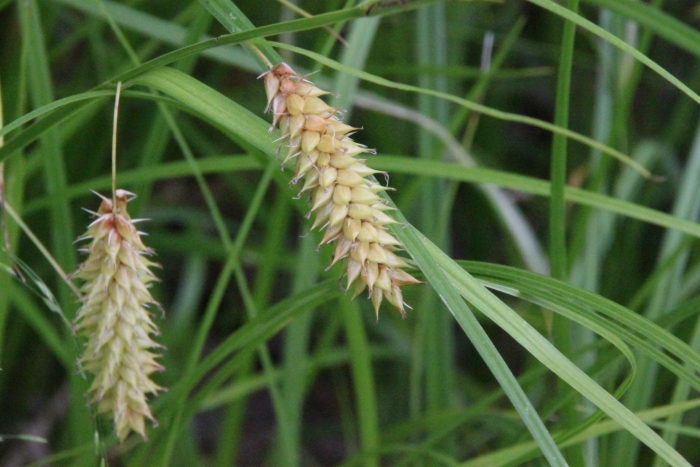Blister Sedge
(Carex vesicaria)
Blister Sedge (Carex vesicaria)
/
/

Maxim Shashkov
CC BY 4.0
Image By:
Maxim Shashkov
Recorded By:
Copyright:
CC BY 4.0
Copyright Notice:
Photo by: Maxim Shashkov | License Type: CC BY 4.0 | License URL: http://creativecommons.org/licenses/by/4.0/ | Rights Holder: Maxim Shashkov | Publisher: iNaturalist | Date Created: 2020-06-20T17:47:22-07:00 |








































Estimated Native Range
Summary
Carex vesicaria, commonly known as Blister Sedge, is a deciduous perennial sedge native to wet meadows, marshes, and along the edges of ponds and streams in North America, Europe, and Siberia. It forms dense clumps with short creeping rhizomes and grows to heights of 30 to 120 cm (12 to 47 in). The stems are triangular in cross-section, rough near the tip, and smoother towards the base. Its narrow, ridged, and pleated leaves can exceed 1 m (3.3 ft) in length, featuring fine toothed edges and sharp points. Blister Sedge produces flower clusters that are long and cylindrical, each containing up to 150 developing fruits that are erect, glossy, and bulbous. The flowering season typically occurs in late spring to early summer, and while the flowers are not particularly showy, they add a subtle texture to the landscape.
Blister Sedge is valued for its ability to thrive in wet conditions, making it suitable for rain gardens, water features, and naturalized wetland plantings. It is also used for erosion control along waterways. In cultivation, it requires part shade to full sun and prefers consistently moist to wet soils. While it is generally low-maintenance, it can spread vigorously and may require management to prevent unwanted expansion. Carex vesicaria is potentially invasive in some regions, so it is crucial to consult local guidelines before planting it outside its native range.CC BY-SA 4.0
Blister Sedge is valued for its ability to thrive in wet conditions, making it suitable for rain gardens, water features, and naturalized wetland plantings. It is also used for erosion control along waterways. In cultivation, it requires part shade to full sun and prefers consistently moist to wet soils. While it is generally low-maintenance, it can spread vigorously and may require management to prevent unwanted expansion. Carex vesicaria is potentially invasive in some regions, so it is crucial to consult local guidelines before planting it outside its native range.CC BY-SA 4.0
Plant Description
- Plant Type: Grass, Herb
- Height: 2-4 feet
- Width: 4-6 feet
- Growth Rate: Moderate
- Flower Color: N/A
- Flowering Season: Spring
- Leaf Retention: Deciduous
Growth Requirements
- Sun: Part Shade, Full Sun
- Water: High
- Drainage: Slow, Wet
Common Uses
Bird Garden, Deer Resistant, Low Maintenance, Water Garden
Natural Habitat
Wet meadows, marshes, and along the edges of ponds and streams
Other Names
Common Names: Bladder Sedge, Inflated Sedge, Lesser Bladder Sedge, Blære-Star, Blasen-Segge, Carex Vésiculeux, Laîche Vésiculeuse, Blaaszegge, Blåsstarr, 새방울사초, 새방울사초(큰방울사초)(둥글레사초)
Scientific Names: , Carex vesicaria, Carex vesicaria var. vesicaria, Carex vesicaria var. monile, Carex monile, Carex turfacea, Carex vesicaria var. raeana, Carex vesicaria f. pendulina, Carex raeana, Carex vesicaria var. dichroa
GBIF Accepted Name: Carex vesicaria L.